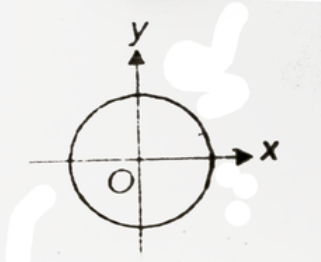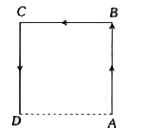Four particles A,B,CandD are situated at the cornerst of a square ABCD of side aatt−0. Each of particles moves with constant speed (v). A always has its velocity along AB,B along BC,C along CB~andD along DA. At what time will these particles meet each other ?
The correct Answer is:alv
Step by step video, text & image solution for Four particles A, B, C and D are situated at the cornerst of a square ABCD of side a at t-0. Each of particles moves with constant speed (v). A always has its velocity along AB, B along BC, C along CB~ and D along DA. At what time will these particles meet each other ? by Physics experts to help you in doubts & scoring excellent marks in Class 12 exams.
Updated on:21/07/2023Topper's Solved these Questions
- MOTION IN A PLANEBOOK - AAKASH INSTITUTECHAPTER - MOTION IN A PLANEEXERCISE - Assignement section -A Objective (one option is correct)
50 Videos
- MOTION IN A PLANEBOOK - AAKASH INSTITUTECHAPTER - MOTION IN A PLANEEXERCISE - Assignement section -B Objective (one option is correct)
24 Videos
- MOTION IN A PLANEBOOK - AAKASH INSTITUTECHAPTER - MOTION IN A PLANEEXERCISE - llustration 1 :
1 Video
- MOCK_TEST_17BOOK - AAKASH INSTITUTECHAPTER - MOCK_TEST_17EXERCISE - Example
15 Videos
- MOTION IN A STRAIGHT LINEBOOK - AAKASH INSTITUTECHAPTER - MOTION IN A STRAIGHT LINEEXERCISE - ASSIGNMENT (SECTION - D)
15 Videos
Similar Questions
The vector quantily among the following is
View SolutionAn object moves at constant speed along a cicular path in a horizontal xy plane. With the centre as origin.when the object is at x= -2m , it s velocity is −4ˆjm/s , its acceleration when it is at y= 2 m/s

View SolutionTwo cars A and B move in mutually perpendicular, directions as shown in the figure . Find vBA
(##AAK_T1_PHY_C02_SLV_051_Q01.png" width="80%">
View SolutionTwo substance of same size are made of same material but one is hollow and the other is solid. They are heated to same temperature, then
View SolutionA : It is not possible to have constant velocity and variable acceleration.
R : Accelerated body cannot have constant velocity.
View SolutionThree particles A, B and C are situated at the vertices of an equilateral triangle ABC of side d at time t=0. Each of the particles moves with constant speed v. A always has its velocity along AB, B along BC and C along CA. At what time will the particles meet each other?
View SolutionFour particles A, B, C and D are situated at the cornerst of a square ABCD of side a at t-0 . Each of particles moves with constant speed (v). A always has its velocity along AB, B along BC, C along CB~ and D along DA . At what time will these particles meet each other ?
View SolutionA particles P moves with speed v along AB and BC , sides of a square ABCD . Another particle Q also starts at A and moves with the same speed but along AD and DC of the same square ABCD . Then their respective changes in velocities are
View SolutionThree particles A,B and C and situated at the vertices of an equilateral triangle ABC of side of length l at time t=0,Each of the particles move with constant speed u. A always has its velocity along AB,B along BC and C along CA.

View SolutionTwo particles A and B separated by 10 m at time t=0 are moving uniformly. A is moving along line AB at a constant velocity of 4m/s and B is moving perpendicular to the velocity of A at a constant velocity of 5m/s. After what time the two particles will be nearest to each other?

View SolutionA particle moves with constant speed v along a circular path of radius r and completes the circle in time T. The acceleration of the particle is
View Solutionतीन कण A , B और C किसी समय t = 0 पर d भुजा वाले समबाहु ABE के शीर्ष बिंदुओ पर है । सभी कण हर समय v चल से चलते है ।A के वेग की दिशा सदा BC की और तथा C के वेग की दिशा सदा CA की और रहती है । किस समय सभी कण एक-दूसरे से मिलेंगे ?
View SolutionFour particles situated at the corners of a square of side ‘a’ move at a constant speed v. Each particle maintains a direction towards the next particle in succession. Calculate the time particles will take to meet each other.
View Solutionएक कण 25 m भुजा वाले वर्ग की भुजाओं AB, BC, CD के अनुदिश 15ms−1 के वेग से गति कर रहा है। इसका औसत वेग हैं।

View SolutionA particle P moves with speed .v. along AB and BC, sides of a square ABCD. Another particle Q also starts at a and moves with the same speed but along AD and DC of the same square ABCD. Then their respective changes in velocities are
View SolutionA particle P moves with speed 'v' along AB and BC, sides of a square ABCD. Another particle Q also starts at A and moves with the same speed but along AD and DC of the same square ABCD. Then their respective changes in velocities are
View Solution

